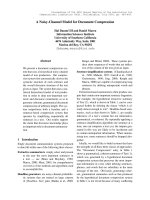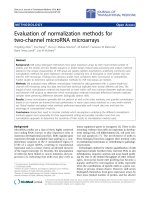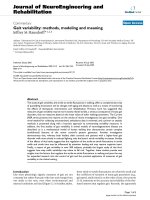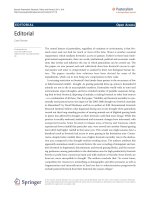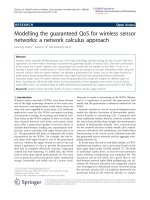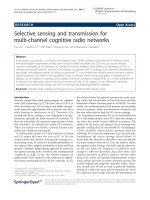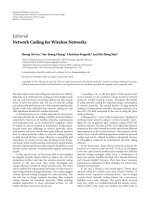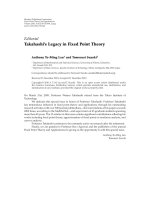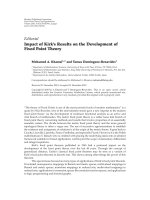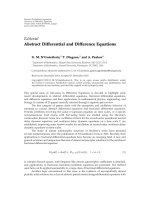Báo cáo hóa học: "Editorial Space-Time Channel Modeling for Wireless Communications" pptx
Bạn đang xem bản rút gọn của tài liệu. Xem và tải ngay bản đầy đủ của tài liệu tại đây (422.01 KB, 2 trang )
Hindawi Publishing Corporation
EURASIP Journal on Wireless Communications and Networking
Volume 2007, Article ID 24595, 2 pages
doi:10.1155/2007/24595
Editorial
Space-Time Channel Modeling for
Wireless Communications
Thushara Abhayapala,
1
M
´
erouane Debbah,
2
and Rodney A. Kennedy
3
1
Research School of Information Sciences and Engineering, The Australian National University, Canberra, ACT 0200, Australia
2
Mobile Communications Department, Eur
´
ecom Institute, 2229 Route des Cr
ˆ
etes, 06904 Sophia Antipolis, France
3
Wireless Signal Processing Program, National ICT Australia (NICTA), Canberra, ACT 2601, Australia
Received 12 December 2007; Accepted 12 December 2007
Copyright © 2007 Thushara Abhayapala et al. This is an open access article distributed under the Creative Commons Attribution
License, which permits unrestricted use, distribution, and reproduction in any medium, provided the original work is properly
cited.
The relatively recent surge in activity centered around
multiple-input multiple-output (MIMO) techniques for
wireless communications is based on capacity gains obtained
by more fully exploiting the spatial and temporal aspects
of wireless channels. The early indications moving to the
use of multiple transmitters and multiple receiver elements
could lead to quite significant performance improvements
that were based on theoretical studies which made quite ide-
alistic simplifying assumptions about the MIMO channel.
Although an understanding of the likely channel models to
be found in practice was incomplete, even a modest portion
of the promised MIMO gains would l ead to significant per-
formance improvements. This has been manifested by the
successful deployment of new wireless standards that have
MIMO products alreadyin the marketplace. Although the-
oretical studies can well define theupper limits to the ca-
pacity gains of MIMO, it is of interest to know how much
of that limiting performance can be obtained under realis-
tic channel conditions. This naturally leads to two classes
of investigation: significant measurement studies of using
MIMO in different real environments and development of
more refined theoretical models that incorporate, in their
structural aspects, what is either observed in practice or ex-
pected in practice. This highlights the important ongoing
role that research into space-time channel modeling plays in
understanding what is practicallyachievable by MIMO tech-
niques.
The goal of this special issue was to present recent results
in space-time channel models which more realistically cap-
ture what is found in pra ctice. The papers to be found in this
issue certainly advance that goal. This special issue collects
eight papers clustered into two groups: papers dealing with
the capture and analysis of channel measurements and pa-
pers dealing with theoretical models.
The first paper by L. Garcia et al. considers measurements
of an indoor and an outdoor wireless channel at 1800 MHz to
guide the selection of the most effective MIMO configuration
particular focusing on spatially configuring two transmitters,
in a 2
×4 configuration, to approach the performance of a 4×
4 configuration. Path loss and spatial correlation properties
for the different configurations are analyzed.
The paper by A. Pal et al. e valuates three candidate an-
tenna array designs for wideband MIMO at a center fre-
quency of 5.2 GHz where the application is in small devices
such as personal digital assistants, mobile phones, and lap-
tops. The wideband MIMO measurements in an open-plan
office environment are compared with results from channel
models which combine measured far field radiation patterns
of the antenna elements with the spatial-temporal multipath
parameters of the channel using a ray tracing model. The di-
versity in polarization, space, and angle are considered.
The third paper by H. Suzuki et al. considers indoor mea-
surements of a 4
× 4 MIMO-OFDM channel operating at
5.25 GHz with bandwidth of 40 MHz corresponding to the
maximum data rate configuration for the IEEE 802.11n stan-
dard. The measurements are done in line-of-sight and non-
line-of-sight-cases. These measurements form the basis of a
critical rev iew of the validity of proposed correlation channel
models.
The fourth and final paper in the first group, which con-
siders measurement, is the paper by M. Landmann et al.
This paper considers the polarization behavior of mobile
radio channel in a macrocell rural environment. The em-
phasis is on modeling changing and transient propagation
2 EURASIP Journal on Wireless Communications and Networking
phenomena which are overlooked in available channel mod-
els. The polarization behaviour is analyzed by separating the
effects due to specular reflections from the diffuse multipath
components.
The second group of papers deals with modeling aspects
and not directly with measurements. As w ith measurements,
the emphasis is to find MIMO models which properly cap-
ture the appropriate wireless environments.
The first paper in the second group of papers is by P.
Almers et al. It is an up-to-date survey of radio propagation
and channel models used to emulate wireless channels for
MIMO systems. A distinction is drawn between two classes:
models that bundle the antenna configuration with the prop-
agation and those that just treat the channel propagation in-
dependent of the antenna configuration. The paper provides
a critical analysis which highlights deficiencies in the cur-
rent MIMO channel and radio propagation models includ-
ing models found in wireless MIMO standards.
The second paper by J-M. Conrat and P. Pajusco presents
a versatile physical channel simulator model developed by
France Telecom for wideband MIMO systems. The simula-
tor incorporates the key physical attributes: geometry, de-
lay, directions of arrival and departure, and polarization. The
model subsumes common simpler ones and has the strong
advantage that permits the implementation of physical mod-
els in a link-level simulation chain. The paper also describes
the software implementation and provides details of the pro-
cessing time efficiency with realistic simulation configura-
tions.
The third model paper by C-X. Wang et al. investigates
the spatialtemporal correlation characteristics of the Spatial
Channel Model in the Third Generation Partnership Project
and the Kronecker Based Stochastic MIMO Model. The spa-
tial temporal separability is investigated at the various levels
(cluster, link, and system) for these two models. Further, the
advantages and disadvantages of these models are discussed
with the Spatial Channel Model being less restrictive but with
greater implementation complexity. This paper also provides
a very useful analysis and classification of different models
which have been proposed in the literature.
The final paper by K. Popovski et al. looks at the ef-
fects multipath propagation on UWB systems and proposes
a time-reversed channel impulse response strategy to imple-
ment prefiltering at the transmitter. This enables the received
signal to be temporally and spatially focused at the receiver.
The IEEE 802.15.3a channel model is employed and a com-
parison is made between time-hopped time-reversed systems
and equalization RAKE-based systems.
ACKNOWLEDGMENTS
We would like to thank all researchers who submitted pa-
pers to this s pecial issue and the large time commitments of
the numerous reviewers. The revisions of the accepted papers
have further enhanced the quality of the papers which should
make this issue a valuable archive of material on Space-Time
Channel Modeling for Wireless Communications. Finally, we
would like to thank the Editorial Office of EURASIP Journal
on Advances in Signal Processing and the Editor-in-Chief for
the unremitting efforts to see this special issue appear in a
timely fashion.
Thushara Abhayapala
M
´
erouane Debbah
Rodney A. Kennedy
